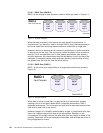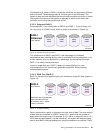Sizing, Considerations, and Recommendations 45
placed on the replacement adapter, thereby removing the "human factor" in
reconfiguring the arrays.
IBM ServeRAID adapter also supports fail-over and hot-swap technology. This
means that in the event of RAID controller failure, then a second or standby
ServeRAID controller can replace the existing adapter automatically. The failed
adapter can be replaced at a convenient time. There is no need to power down
the server to replace the failed adapter, as it can be hot-swapped, keeping the
system available to users.
5.2.6.3 Memory
Memory is of the utmost importance in determining the reliability and
performance of any system. Installing memory to capacity is an obvious choice to
achieve high performance. However, this will only achieve high performance for
the memory of the system, and is an expensive way of ensuring you have
optimum memory performance.
To address this issue, look at the memory requirements of the whole system, then
round this up to the nearest size of memory available for the system.
So how do you determine the amount of memory required?
List the software that will be running on the system, then add up each of the
individual network operating system and application requirements. This basic
approach will help you to determine the desired amount of memory. This figure
should be used as a guide since there are many factors that will influence the
amount of actual memory required within a system.
Another consideration for business-critical servers is the flexibility of the memory
being used. For example, what happens if a memory DIMM should fail? Will the
server stop working or will it keep going?
In high-end servers today, the failure of a single DIMM should not stop the
system. The memory controller should be intelligent enough to switch off a single
DIMM, or switch off a bank of DIMMs if using memory interleaving to enable the
server to keep functioning. Where a single DIMM or a bank of DIMMs are
switched off, there will be some performance degradation. How much
performance degradation will depend upon the way in which the memory and the
whole server has been configured. Under some operating systems there may be
the requirement of a reboot of the system to switch off the memory. If you want to
take advantage of this type of feature, be sure to check if it’s supported on the
hardware.
5.2.6.4 Fans
Fans in today’s Intel-based servers are of critical importance. In tests, an
eight-degree rise in temperature can reduce the system life by around 10 to 15%,
while creating intermittent errors throughout the system.
The IBM Netfinity range of servers incorporate a fan monitoring system and a
temperature or environmental monitoring system. Sensors constantly monitor the
fans rotation and temperature, reporting back to the system management
hardware or software of any variation, outside of tolerance.
Some models of IBM Netfinity servers incorporate a "spare fan" design, such that
the loss of a single fan will not raise the temperature above the design


















